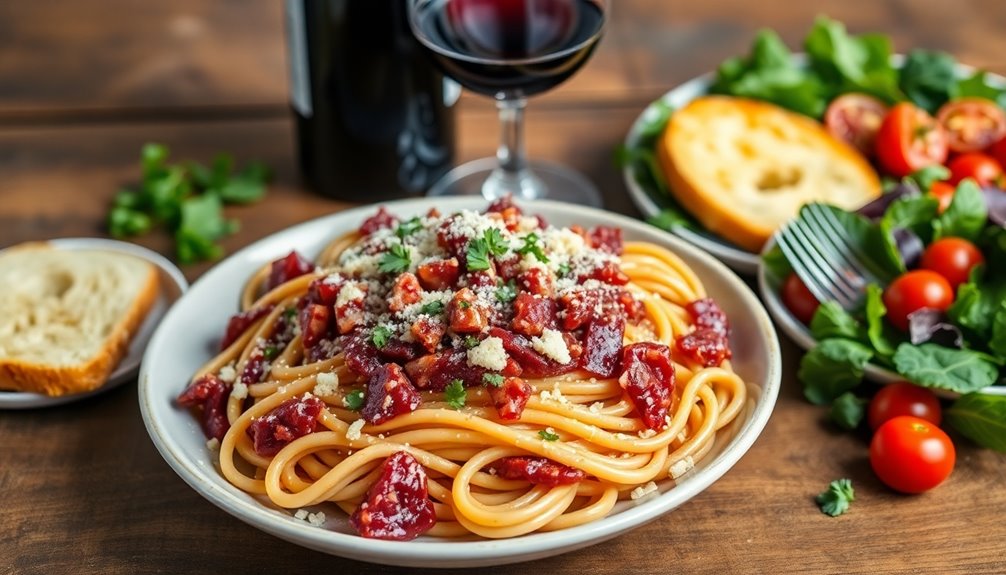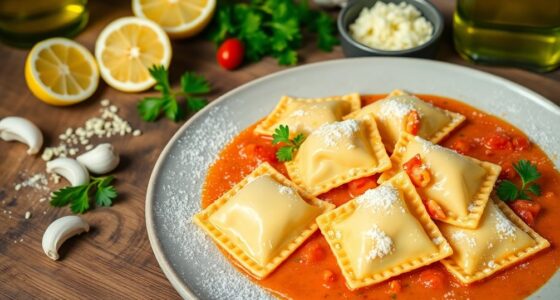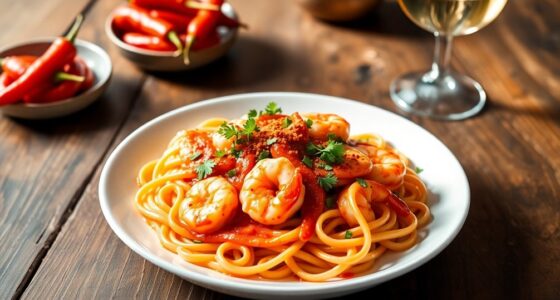Red Wine Bucatini with Pancetta and Parmesan is a delicious and easy dish you can whip up in about 45 minutes. Start by cooking bucatini pasta until al dente, then crisp up some pancetta. Sauté minced garlic and red pepper flakes in the pancetta fat, and add a bottle of red wine to reduce into a flavorful sauce. Combine everything and finish with freshly grated Parmesan. Stick around, and you'll uncover more tasty tips and history behind this indulgent pasta dish.
History
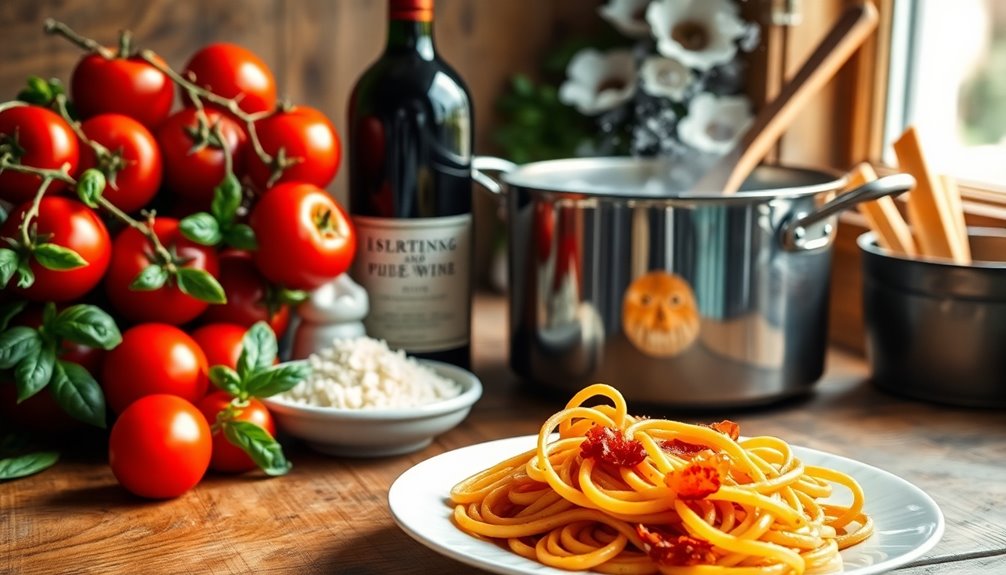
When you explore the history of Red Wine Bucatini, you'll find its roots in traditional Italian pasta dishes that celebrate simple, high-quality ingredients. This dish draws inspiration from classics like cacio e pepe and carbonara, showcasing how local flavors meld beautifully. The use of red wine dates back to regions in Italy where wine was a staple, reflecting the culinary tradition of integrating seasonal ingredients. Bucatini, a thick pasta with a hollow center, hails from the Lazio region and pairs perfectly with rich sauces. Additionally, pancetta, a beloved Italian cured meat, has added depth to pasta dishes for centuries. The culinary traditions of various cultures, including those found in Africa, highlight the importance of using fresh and local ingredients in creating memorable meals. Together, these elements create a vibrant culinary experience, honoring the robust flavors of Italian cuisine.
Recipe
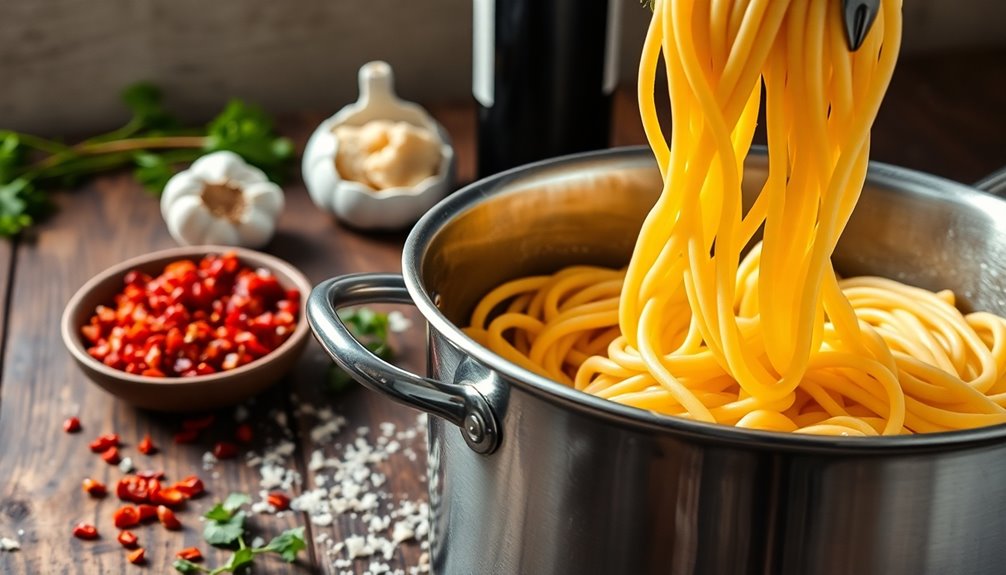
Ingredients:
- 1 pound bucatini pasta
- 8 ounces pancetta, diced
- 4 cloves garlic, minced
- 1 teaspoon red pepper flakes
- 1 bottle (750 ml) red wine
- 4 tablespoons unsalted butter
- Freshly grated Parmesan cheese, for serving
- Salt, for pasta water
- Freshly ground black pepper, to taste
- Fresh parsley, chopped (optional, for garnish)
Instructions:
Begin by cooking the bucatini pasta in a large pot of salted boiling water until al dente, according to package instructions.
While the pasta cooks, heat a large skillet over medium heat and add the diced pancetta, cooking until crispy. Remove the pancetta from the skillet and set aside, leaving the rendered fat in the pan.
In the same skillet, add minced garlic and red pepper flakes, sautéing until fragrant. Pour in the entire bottle of red wine, bringing it to a simmer and allowing it to reduce by half, which should take about 10-15 minutes.
Once the wine has reduced, add the cooked bucatini and crispy pancetta to the skillet, tossing everything together with butter until well combined. Finish with freshly grated Parmesan and season with salt and pepper to taste.
Extra Tips:
For the best flavor, choose a good-quality red wine that you enjoy drinking, as this will enhance the overall taste of the dish.
If you prefer a different flavor profile, consider substituting pancetta with prosciutto for a slightly sweeter taste.
Additionally, feel free to experiment with the amount of red pepper flakes based on your spice preference.
To elevate the dish further, serve it with a side of garlic bread and a fresh salad for a complete meal that's sure to impress.
Cooking Steps
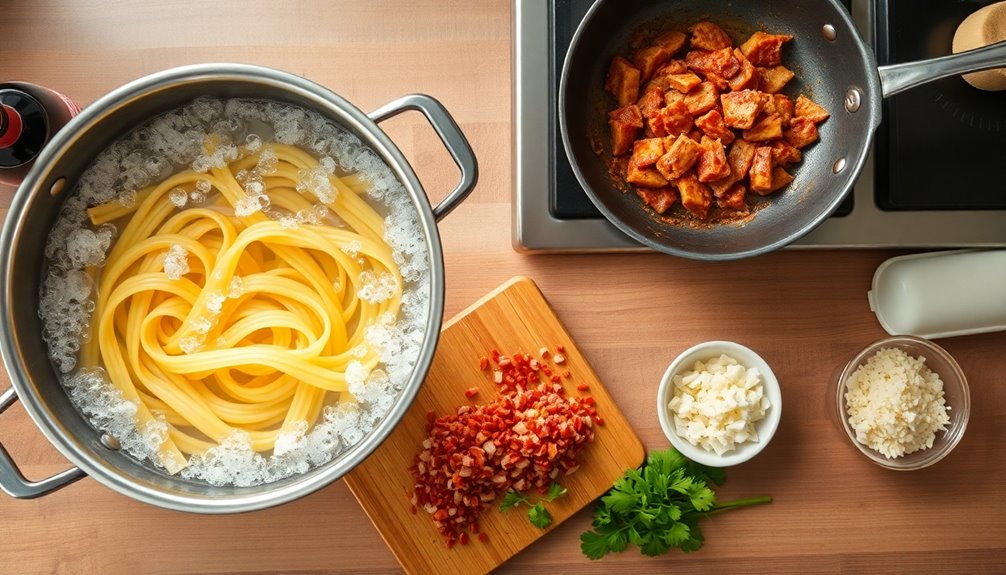
To get started on your Red Wine Bucatini, you'll boil salted water for the pasta while crisping pancetta in a skillet.
Once that's done, you'll add red wine to the skillet and let it simmer until thickened.
Finally, combine the al dente pasta with the rich sauce for a delicious finish.
Step 1. Boil Salted Water for Pasta
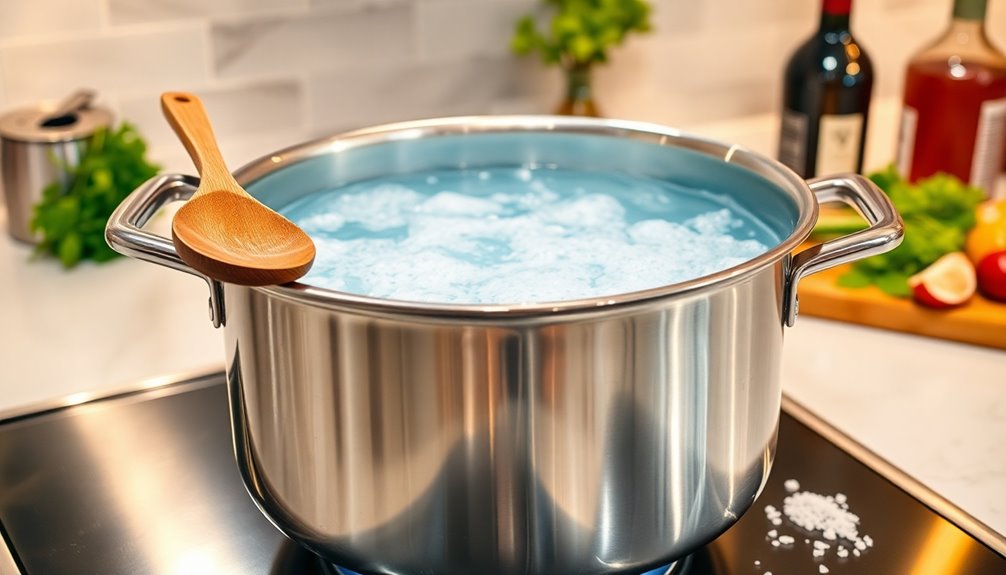
Start by filling a large pot with enough water to fully submerge the bucatini for even cooking.
Add a generous amount of salt—about 1-2 tablespoons—to the water. This enhances the pasta's flavor as it cooks.
Bring the water to a rolling boil over high heat; this step's essential to prevent the pasta from becoming gummy.
Once the water's boiling, carefully add the bucatini, stirring gently to keep it from sticking together.
Cook the pasta until it's very al dente, usually 1-2 minutes less than the package instructions.
Remember, it'll continue to cook when you toss it with the sauce later.
Keep an eye on it to achieve that perfect texture!
Step 2. Add Pancetta to Skillet

Once you've got your water boiling, it's time to focus on the pancetta.
Start by cutting the pancetta into small pieces for even cooking and maximum flavor.
Heat a skillet over medium heat and add the pancetta, cooking it until crispy, which should take about 5-7 minutes.
Keep an eye on the grease it releases; drain any excess fat if necessary to prevent an overly greasy dish.
Once the pancetta is crispy, remove it from the skillet, leaving the rendered fat behind for added flavor.
You'll incorporate this sautéed pancetta back into the dish later when you toss the bucatini with the red wine sauce, ensuring its rich flavor is evenly distributed throughout the pasta.
Additionally, cooking in a clean environment can significantly reduce allergens and pollutants, making the process healthier and more enjoyable.
Step 3. Add Wine to the Skillet
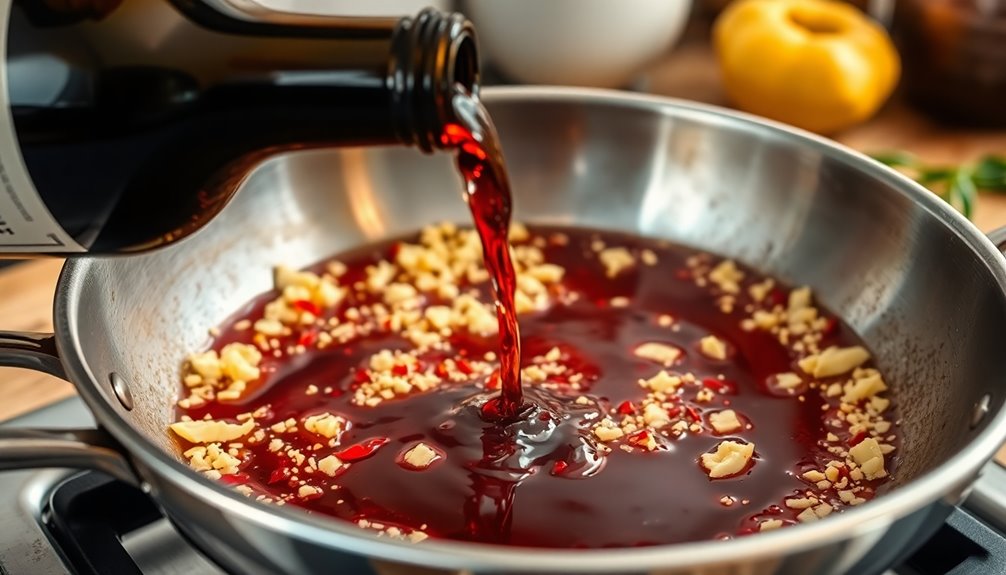
As the pancetta crisps in the skillet, sauté the garlic and red pepper flakes in butter until fragrant.
Next, pour in an entire bottle of red wine, creating a rich sauce that will elevate your dish. Stir the wine into the skillet, ensuring it blends well with the sautéed ingredients.
Allow the red wine to reduce by half, concentrating its flavor and deepening the sauce's richness. This reduction also helps achieve a silky texture that clings beautifully to the bucatini.
To balance the wine's acidity, add a bit more butter and mix in the crispy pancetta before tossing in the cooked pasta. This step is essential for a harmonious and flavorful finish to your dish.
Step 4. Simmer Sauce Until Thickened
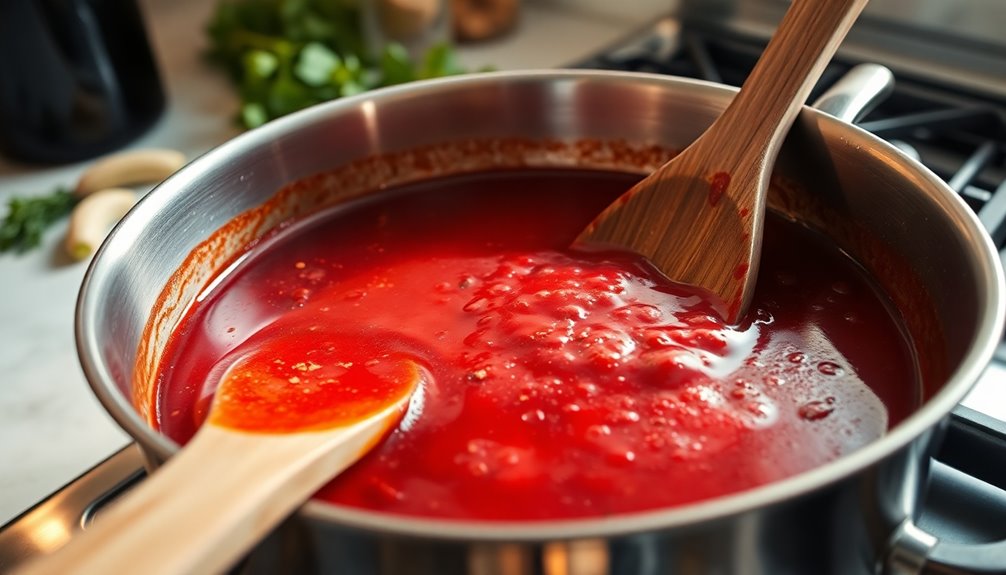
With the wine reduced and flavors melded, it's time to simmer the sauce until it thickens.
Pour in the entire bottle of red wine and set the heat to medium, allowing it to bubble gently. This helps avoid boiling over while concentrating the flavors.
Stir the sauce periodically to prevent sticking and guarantee an even distribution of the delicious tomato sauce and pancetta.
You'll know it's ready when it thickens enough to coat the back of a spoon, signaling that the alcohol has evaporated and the flavors have melded beautifully.
For an extra flavor boost, incorporate the cooked pancetta and any additional seasonings, like butter and Parmesan, into the thickened sauce before combining it with the bucatini.
Step 5. Combine Pasta and Sauce
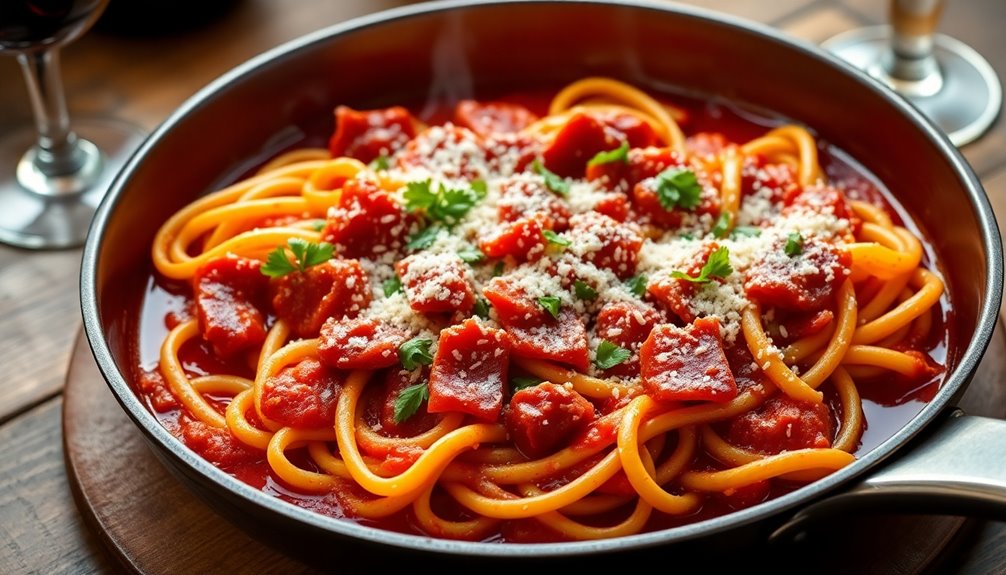
To combine the pasta and sauce effectively, start by cooking the bucatini in boiling salted water until it's very al dente, since it'll keep cooking when you toss it with the sauce.
Once your red wine sauce has reduced by half, add the crispy pancetta, then drain the bucatini, reserving some pasta water.
Toss the drained pasta into the sauce, ensuring each strand is evenly coated. If the sauce seems too thick, add a splash of the reserved pasta water to help it cling better.
For extra richness, stir in a bit of butter.
Finally, serve the dish garnished with freshly grated Parmesan and parsley, enhancing both flavor and presentation.
Enjoy your delicious red wine bucatini!
Final Thoughts
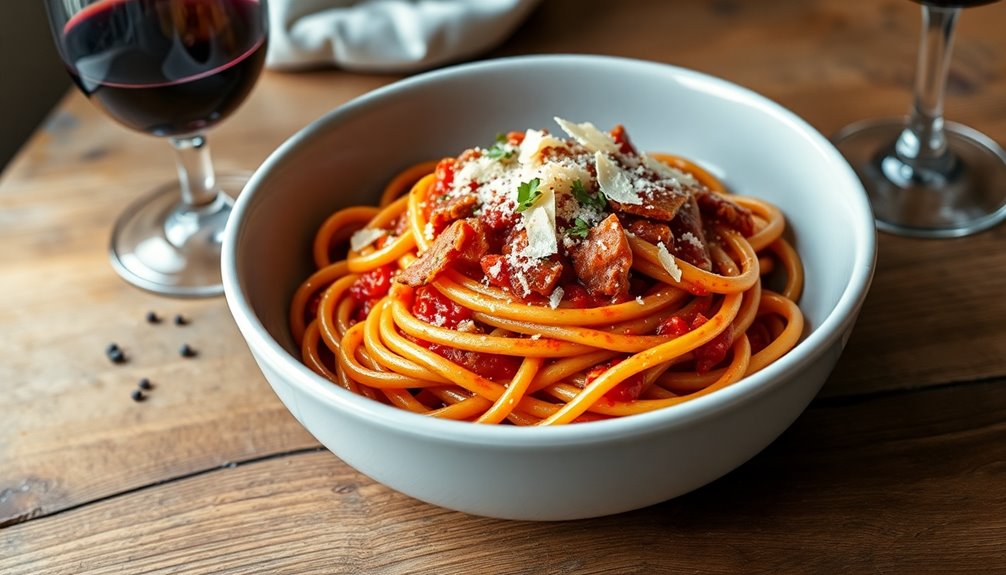
While you might think cooking a dish like Red Wine Bucatini requires culinary expertise, it's surprisingly simple and rewarding. This romantic meal, perfect for special occasions, brings together the rich flavors of pancetta and red wine in just 45 minutes.
You'll impress your guests while enjoying a delightful dining experience. The technique of reducing a whole bottle of red wine creates a sauce that beautifully coats the bucatini, enhancing its flavor.
Don't forget to serve it with crispy garlic bread for a comforting touch. If you want to mix things up, consider swapping pancetta for prosciutto.
With its elegance and straightforward preparation, this dish is sure to become a favorite in your culinary repertoire. Enjoy!
Frequently Asked Questions
Can I Substitute Bucatini With Another Pasta Type?
Sure, you can definitely substitute bucatini with another pasta type!
While some might argue that the texture and shape of bucatini are unique, you'll still find delightful options. Spaghetti or fettuccine are great alternatives, as they'll hold sauces well.
If you're in the mood for something different, try penne or rigatoni for a fun twist. Just cook according to the package instructions, and you'll still end up with a delicious dish!
What Type of Red Wine Works Best for Cooking?
When it comes to cooking with red wine, you'll want to choose something that enhances your dish's flavors.
A dry red wine, like Cabernet Sauvignon or Merlot, works well because they add depth without overpowering. Avoid overly sweet wines; they can alter the dish's taste.
If you wouldn't drink it, don't cook with it! Always aim for quality, as it greatly impacts the final flavor of your meal.
Is This Dish Suitable for Meal Prep?
Yes, this dish is suitable for meal prep!
You can cook it in batches and store it in airtight containers in the fridge.
When you're ready to eat, just reheat it on the stove or in the microwave.
Keep in mind that pasta tends to absorb sauce over time, so you might want to add a splash of water or extra sauce while reheating to maintain its flavor and texture.
Enjoy your convenient meals!
How Can I Make It Vegetarian-Friendly?
Did you know that nearly 30% of the U.S. population identifies as vegetarian or flexitarian?
To make your dish vegetarian-friendly, swap out pancetta for sautéed mushrooms or smoked tempeh for a savory depth. Use vegetable broth instead of any meat-based stock, and make certain your Parmesan is a vegetarian-friendly option.
You can also add seasonal veggies or a sprinkle of nutritional yeast for extra flavor, keeping it delicious and satisfying without the meat.
What Sides Pair Well With This Dish?
When you're considering sides to pair with your dish, think about balance and flavor. A fresh arugula salad with lemon vinaigrette adds a peppery contrast.
Roasted seasonal vegetables bring warmth and depth. Garlic bread can complement the sauce beautifully, while a light antipasto platter offers variety.
For a touch of elegance, serve a simple bruschetta topped with tomatoes and basil. These options will enhance your meal and create a delightful dining experience.
